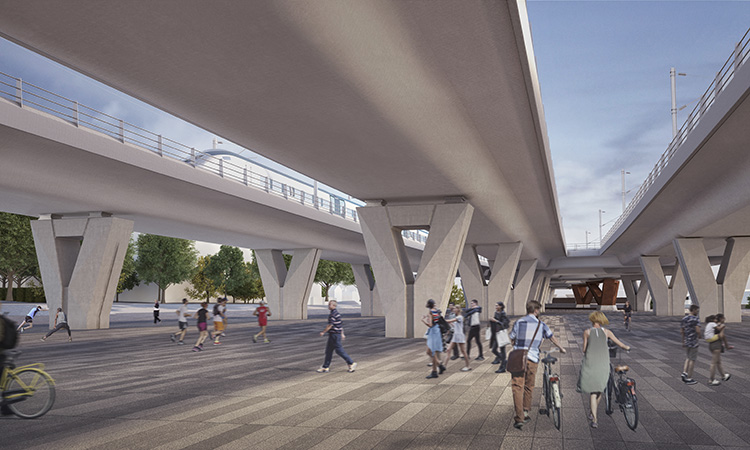HS2 granted planning permission by Birmingham City Council for two viaducts
Posted: 20 June 2022 | Elliot Robinson (Editorial Assistant - Global Railway Review) | No comments yet
HS2 have been given planning permission for two viaducts which will take the railway into Curzon Street Station in Birmingham’s city centre.


Credit: HS2
HS2 Ltd has been granted planning permission by Birmingham City Council for two viaducts which will take the new high-speed railway into Curzon Street Station in the city centre. Curzon Viaduct No.3 and Lawley Middleway Viaduct are part of the Curzon Street Station Approach area, which is made up of four connected viaducts between Duddeston Junction Viaduct and Curzon Street Station in central Birmingham. The other viaducts are Curzon Street No.1 Viaduct (furthest from the station) and Curzon Street No.2 Viaduct which is currently undergoing a planning application.
A number of design refinements have resulted in a shorter construction programme and less concrete needed to build the viaduct, bringing positive environmental and community benefits. The viaducts are being designed by a Design Joint Venture of Mott MacDonald and Systra and architects Weston Williamson + Partners, all working for HS2’s civils contractor Balfour Beatty VINCI joint venture.
“This decision represents a significant approval for HS2 in Birmingham city centre and means we are on track to bring high speed rail to the West Midlands, increasing capacity and connectivity across the UK,” David Speight, Client Project Director at HS2 Ltd, said. “In addition, our design refinements on the viaducts will bring a range of extra benefits, including reducing the construction time and materials, reducing the amount of carbon we need on the project.”
📣 We have been granted planning permission by @BhamCityCouncil for two viaducts which will take the new high speed railway into #HS2‘s Birmingham Curzon Street Station in the city centre.
— HS2 Ltd (@HS2ltd) June 20, 2022
“BBV and the DJV design team have brought their global expertise to tackle the significant engineering challenges involved in fulfilling HS2’s design vision for this iconic structure, which will provide a catalyst for social and economic development,” Nick Robertshaw, Project Manager from the Design Joint Venture Mott MacDonald and Systra, said. “This landmark milestone for the programme has only been made possible through the ‘one team approach’ facilitated by HS2 with Birmingham City Council, whose critical input and collaboration has enabled this achievement.”
“The key design challenge of Curzon 3 was to address varied sites with differing technical requirements whilst providing both a level of consistency as well as ensuring the viaduct contributes positively to its surroundings,” Nick McGough, Director at Weston Williamson and Partners, said. “Toward the HS2 Curzon Street Station the viaduct is over 60m wide and so the design maximises daylight under the structure through the introduction of light slots with a unique lightweight parapet design. Over the Digbeth Canal the opportunity is taken to reference Birmingham’s canalside heritage whilst the large span required over Lawley Middleway is achieved through the use of heroic weathering steel girders which arch over the carriageway.
Related news you may enjoy:
HS2 announce the start of construction on UK’s longest railway bridge
Laser and drone technology recreate iconic Victorian railway viaduct
HS2 reveals carbon saving modular design for Thame Valley Viaduct
The Curzon Viaduct No.3 is approximately 300 metres long, the height above ground level varies between 5 metres to 6 metres, it is 65 metres wide at the widest point and will be supported by 30 piers. As it approaches Curzon Street Station, the deck of the viaduct widens from a single deck at the eastern end to four separate decks at the western end.
The viaduct will widen to four separate decks near Curzon Street Station to maximise daylight in the public space underneath. V piers have been developed to support the viaducts because they take up less room at ground level and will also have a side recess for future potential services to be visually integrated. As well as separating the viaduct into four separate decks, the V piers will also help to maximise the opportunities to create a usable and flexible public space under the viaduct.
As Curzon Street No.3 Viaduct crosses the Digbeth Canal, the concrete V piers are substituted with four inverted steel piers which reference the heritage of canal-side cranes in Birmingham. This also means the Digbeth Canal area will remain a visually attractive area to the public, combining the twenty first century HS2 infrastructure and the nineteenth century Digbeth Canal area, ensuring a positive legacy for this part of the city.
Through the development of the designs, the width of the viaduct has been reduced from 71 metres to 65 metres. The Curzon Street Pumping Station that was previously located south of the viaduct has been removed from the design as water that gathers on the viaduct will now be drained into either an attenuation pond or attenuation tank located underground.
Related topics
High Speed Two (HS2), Infrastructure Developments, Operational Performance, Regulation & Legislation
Related organisations
Balfour Beatty VINCI, Birmingham City Council, HS2 Ltd (High Speed Two), Mott MacDonald, Systra, Weston Williamson and Partners








